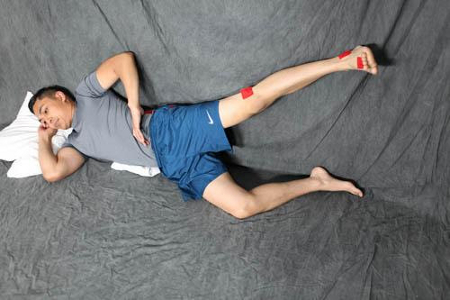Approach
The goal of treatment is to minimize the friction of the iliotibial band (ITB) as it slides over the femoral condyle. Initially, treatment includes drugs for pain relief and to reduce inflammation.[35] Further treatment requires activity modification, massage, and stretching and strengthening of the affected limb.
Acute
The goal of the initial treatment is to reduce local inflammation and provide effective pain relief using nonsteroidal anti-inflammatory drugs.
Activity modification is essential. In mild cases, the athlete ought to stay below the time or distance at which the symptoms begin. In more severe cases, the athlete is advised to avoid all aggravating activity and commence alternative forms of training such as swimming (using only the arms) with a pool buoy to maintain fitness. Any activity that requires repeated knee flexion and extension is prohibited.[36]
Corticosteroid injections are recommended for patients with severe pain or swelling and as a means to progress the rehabilitation.[37] An injection is rarely curative as a solitary treatment modality.[Figure caption and citation for the preceding image starts]: Injection site for iliotibial bandFrom the personal collection of Dr J.C. Mak [Citation ends].
Subacute
During the subacute phase, emphasis is on stretching of the ITB and soft-tissue therapy for any myofascial restrictions. Biomechanical abnormalities can be addressed where possible. Stretching exercises are started after acute inflammation subsides. Particular attention is given to increasing the length of the tensor fascia lata/ITB complex. Myofascial restrictions along the lateral hip and thigh, however, can be addressed. These include trigger points, muscle contractures, and fascial adhesions. Identifying and eliminating these restrictions precedes strengthening and muscle reeducation. Soft-tissue treatment usually eliminates a significant part of the pain pattern and allows definitive and more successful ITB syndrome treatment. Combining this treatment with use of a foam roll and performing isolated stretches for tight muscles are particularly effective in releasing myofascial restrictions.
Recovery and strengthening
Strengthening exercises can begin once range-of-motion and myofascial restrictions have been resolved.[7] Exercises are designed to improve the hip abductor strength and integrated movement patterns. A final return-to-running phase follows recovery and strengthening.[Figure caption and citation for the preceding image starts]: Hip abduction in side-lying position with hip extended for posterior gluteus medius emphasisBaker RL et al. Iliotibial band syndrome in runners: biomechanical implications and exercise interventions. Phys Med Rehabil Clin N Am. 2016 Feb;27(1):53-77; used with permission [Citation ends].
Refractory to conservative treatment
The majority of patients will respond to a nonsurgical approach as outlined. Surgery, if required, involves either resection or Z-lengthening of the ITB to decrease impingement of the ITB on the lateral femoral epicondyle.
Use of this content is subject to our disclaimer